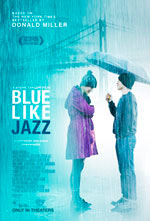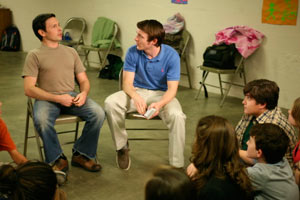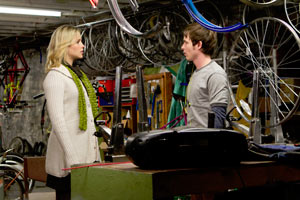
Blue Like Jazz

 – for mature thematic material, sexuality, drug and alcohol content, and some language.
– for mature thematic material, sexuality, drug and alcohol content, and some language.
Director: Steve Taylor
Starring: Marshall Allman, Claire Holt, Tania Raymonde, Justin Welborn, Jenny Littleton, Eric Lange, Jason Marsden
Running Time: 1 hour, 46 minutes
Theatrical Release Date: April 13, 2012
Official Site

Plot Summary
Don, a nineteen-year-old sophomore at a Texas junior college, tries to escape his Bible Belt upbringing for life in the Pacific Northwest at the most godless campus in America.
(from IMDB.com)
Film Review
By now, it’s easy to have pre-conceived notions as to the kind of film you’re going to get when walking into one that’s dubbed a “Christian film.” By association, Steve Taylor’s adaptation of the book Blue Like Jazz fits the bill, but by the quality and content you can expect from a “Christian film,” Blue Like Jazz is in a league of its own. [Warning: Some minor plot spoilers ahead, but I’ll try to be as vague as possible]
I’ll begin by saying I have not read Donald Miller’s book Blue Like Jazz. The film is my first introduction to Miller and the world he’s created with the story. The story serves as one that is influenced by Miller’s own life experiences, as the movie’s main character is actually named Don Miller. However, only some of the film’s story elements are true, but the point and message of the film is as true and heartfelt as Miller can present it. With the help of budding indie film director Steve Taylor (who is known in the Christian community mostly for his solo music in the 80s and 90s and his stellar production work with artists like Newsboys and Sixpence None The Richer), Miller’s ambitious and controversial story has been given wings, the end result of which is impactful… and has the potential to offend viewers almost as much as it does to inspire.

Most Christian-made films have a stigma for being poorly written, poorly directed, and especially poorly acted, and Blue Like Jazz avoids all of these well. While the heart and intentions are often in the right place with Christian films, there’s a sanitized approach that is admirable for its reasoning, but often times is done in a hamfisted, unrealistic way, coupled with a spiritual conversion element that seldom, if ever, feels genuine. Still, a film like Fireproof, which does suffer from many of these problems, still managed to stir emotions and inspire. The truth is, we don’t always need to see the real ugliness of life portrayed in its most realistic form to have a point conveyed effectively. However, Blue Like Jazz is a story that pretty much needs to be told in the way that it is. And that particular way isn’t one you’ll find stamped with a “Dove Approved” seal or recommended purchasing on Christian bookstore end caps anytime soon. As Steve Taylor puts it on BlueLikeJazzMovie.com, “I made it clear to all our potential investors and/or heads of media companies, the vast majority of whom were fellow Christians, that this was not going to be a family movie. The reason was simple: How do you tell the story of a college kid who flees his Southern Baptist upbringing in suburban Houston to attend the ‘most godless campus in America’ without showing what that environment is like? And how can that environment be portrayed realistically in the context of a ‘family’ movie? Doesn’t have to be rated R, but it’s probably going to be PG-13, right?”
Blue Like Jazz follows the life of a young man named Don Miller who is raised Southern Baptist by his mom in a small town in Texas. His dad is a pothead, which had lead to his parents getting divorced, and in the midst of getting ready to go off to college, he finds out that his dad has enrolled him at Reed College in Portland, Oregon. He turns down his dad’s offer with plans to go to a local Christian college, but a disenchanting realization about some infidelity among a leader at his church pushes him to spontaneously hop in his car and drive to Portland to move into the dorms at Reed. He immediately is greeted by a rude awakening; many of the students are flamboyant and outrageous characters who are confident of who they are, but Don himself has begun to question everything he believes, sparked by the hypocrisy he saw in the church. He soon falls in with the wrong crowd, turning to drinking and partying and doing things he previously had never dreamed of doing. He basically comes to the point where he has renounced his faith when he discovers that the girl he’d begun pursuing is a self-proclaimed believer in Jesus. When he learns that she not only wasn’t raised a believer, but accepted Jesus only a year or so before their meeting because she truly loves Him, this really challenges his thinking.
While at Reed, Don meets people of all kinds of backgrounds – gay, straight, bi, agnostic, drug-addicts, abused: real people with real issues and beliefs from all different kinds of backgrounds. It’s enlightening to him, but he allows his confusion and disillusionment about what he believes to lead him to make some pretty terrible choices. In the midst of all of this, we see that God still has His hand on Don and his life. Everything that transpires during Don’s story leads up to a scene where the true heart of Blue Like Jazz is revealed. And it proves to be, arguably, one of the most powerful scenes to appear in a “Christian film” to date. Don ultimately discovers what it really means to believe in and follow Jesus, making an ephiphany that every believer can take to heart, and maybe even learn from.

To paint the picture of Don’s prodigal son story as accurately as possible without presenting it in its probably more realistically rated-R fashion, Taylor and Miller opt for a solid PG-13 packaging, which includes some profanity, frequent sexually-related remarks and content and lots of drinking (and some drugs). There’s a handful of uses of the “S” and “a” words, as well as one sort of incomplete use of the “F” word from Don (the audio wasn’t the clearest at our screening, but it was pretty unmistakable). The movie handles things like sexuality and homosexuality in a pretty frank manner, while one scene shows a large blow-up condom balloon (that was used as part of a table display at a fair on campus) draped over a church steeple as part of a prank that’s pulled on the church. There’s a sense of irreverence that is portrayed — not by Miller and Taylor, but by the characters who fight the belief in the existence of God, which leads them to do such things. Another scene involves a character telling Don about a story he’d heard about a young man who had been molested by a Catholic priest as a child. In addition to that, there’s a character on campus who dresses as a pope and claims to speak for God, although he does it in a deliberately offensive way. While the character is based on a real-life character Miller encountered at Reed, these aspects are likely to offend Catholics, although they aren’t presented in Blue Like Jazz for any other reason than to tell Miller’s story (One Catholic at the screening I attended was deeply offended, while another insisted that they were not offended by it). Taylor and Miller set out to address real issues, real pain and real hurt in this film, and because these things are “real life” for these people, they are represented in this film. The only thing, aside from some of the sexual comments seeming a little unnecessary to include, was that I did feel like some of the profanity was a little much. While it’s about on par with most PG-13 films, and is included with the intentions of grounding the film in more of a sense of reality, it still felt like a bit much for the film’s core audience and demographic. Perhaps it’s the fact that we know as we’re watching it that this is a “Christian film” of sorts and this kind of content is usually avoided to make the films more acceptable and honoring of God, I don’t know, but at the same time, I do fully understand why Taylor and Miller decided to tell this story in this way. It’s not a movie with the sole purpose to entertain; it’s a movie that hopes to serve as a reality check to believers trying to ignore touchy subjects, while at the same time re-presenting the Gospel message in an honest and realistic way–at least from the perspective of this young man’s coming-of-age spiritual experiences.
While Steve Taylor’s last directorial outing, The Second Chance, suffered from some flawed acting, Miller and Taylor have assembled a pretty skilled team of players this time around. Young actor Marshall Allman, who has appeared in shows like True Blood and Prison Break is great as Don, delivering a well-rounded and emotional performance. Claire Holt (from TV series The Vampire Diaries) is charming as the object of Don’s affection, Penny, while Justin Welborn also does an excellent job as “The Pope.” While Blue Like Jazz definitely has an indie film feel to it from start to finish (which is only bolstered by some pretty terrible CG animation in a couple scenes, but it’s forgivable given the film’s low budget), Taylor does an excellent job giving it a quality feel regardless. The strong acting certainly helps, but a hip soundtrack (that isn’t limited to a list of popular CCM artists associated with the film company’s record label), featuring songs that actually gel with what we’re watching on screen, does strengthen the end result.
In the end, Blue Like Jazz is a powerful film that is different than anything you’ve ever seen associated with Christian filmmaking. The content is pretty rough and the movie does earn its PG-13 rating very well, but I’m not sure this story could have been told as impactfully if handled much differently (and that is coming from a movie watcher who really believes that movies do not need vulgarity to be good or entertaining). If youth leaders are considering screening this for their kids, I highly recommending seeing it first before doing so to allow for time to appropriately prepare yourself to discuss topics addressed in the film. It’s not a family film by any means, but there is a wealth of things to discuss in Blue Like Jazz, so a well prepared Bible study could spark some fantastic discussion. Christian filmmakers can also learn a lot from Taylor’s handling of, not only the Blue Like Jazz material, but also the quality of its presentation. The message of a Christian film is extremely important, but the way its told is just as crucial. Blue Like Jazz raises the bar for Christian filmmaking, and I’m eager to see what project Taylor devotes his talents to next.
– John DiBiase, (reviewed: 3/23/12)
Parental Guide: Content Summary
![]() Sex/Nudity: Lots of frank sexual references and innuendo. Don’s friend talks about his mom and wanting to sleep with her (in a sort of joking manner), and says something about her slowly taking off her shirt as he watches; Don listens to a flirtatious phone message from what sounds like a Hispanic man and then we see a sweaty, shirtless, well-fit man doing yardwork outside his window; While Don is sitting talking with his dad, a comment is made about his dad sleeping with students he teaches. We then see a girl come out of his trailer wearing his dress shirt, but it looks as though she may just be in her underwear (if that) underneath; We learn that a woman is having an affair with a married man; We see a sort of sexy-looking woman in a carrot suit, first as a digital cartoon and then later as a real person dressed in a costume; We see a bumper sticker that says “Abstinence makes the heart grow fondlers;” Two women walk into the mens room at college and one stands up and uses the urinal. Later, Don sees her and she comments on being a lesbian and asks Don if he knows how to tell if another woman is a lesbian and says that her “*ss gets bigger;” We see a bulletin board with photos of people with the label “bi-curious” underneath one; Don tries to fit in and makes a sexual reference about “popping” someone’s “tart;” Don is handed a pile of condoms at a fair. We also see a large blow-up balloon of a condom with a smiley face on it; Lauryn comes into Don’s room and lies in bed with him, upset that a girl she likes is straight. She asks if she can stay with Don and he asks half-jokingly if she’ll “put out.” She asks him to be serious and he remarks that he remembers when she used to be “bi-curious” (to which she replies she remembers when he used to be nice). Later, “The Pope” asks Don if he knows he has a lesbian in his bed; We hear the story of a young man who had been molested by a priest; We find out a woman who had been having an affair with a married man is pregnant; We see a church steeple with the condom balloon pulled over it that was done as a prank. A comment about asking the church people to stop reproducing is written in graffiti on the building; A large man kisses Don as part of a ritual during a massive party; We see Don in just his boxers after he gives his dirty laundry to someone; More innuendo and references to sex and lesbianism are made during the film.
Sex/Nudity: Lots of frank sexual references and innuendo. Don’s friend talks about his mom and wanting to sleep with her (in a sort of joking manner), and says something about her slowly taking off her shirt as he watches; Don listens to a flirtatious phone message from what sounds like a Hispanic man and then we see a sweaty, shirtless, well-fit man doing yardwork outside his window; While Don is sitting talking with his dad, a comment is made about his dad sleeping with students he teaches. We then see a girl come out of his trailer wearing his dress shirt, but it looks as though she may just be in her underwear (if that) underneath; We learn that a woman is having an affair with a married man; We see a sort of sexy-looking woman in a carrot suit, first as a digital cartoon and then later as a real person dressed in a costume; We see a bumper sticker that says “Abstinence makes the heart grow fondlers;” Two women walk into the mens room at college and one stands up and uses the urinal. Later, Don sees her and she comments on being a lesbian and asks Don if he knows how to tell if another woman is a lesbian and says that her “*ss gets bigger;” We see a bulletin board with photos of people with the label “bi-curious” underneath one; Don tries to fit in and makes a sexual reference about “popping” someone’s “tart;” Don is handed a pile of condoms at a fair. We also see a large blow-up balloon of a condom with a smiley face on it; Lauryn comes into Don’s room and lies in bed with him, upset that a girl she likes is straight. She asks if she can stay with Don and he asks half-jokingly if she’ll “put out.” She asks him to be serious and he remarks that he remembers when she used to be “bi-curious” (to which she replies she remembers when he used to be nice). Later, “The Pope” asks Don if he knows he has a lesbian in his bed; We hear the story of a young man who had been molested by a priest; We find out a woman who had been having an affair with a married man is pregnant; We see a church steeple with the condom balloon pulled over it that was done as a prank. A comment about asking the church people to stop reproducing is written in graffiti on the building; A large man kisses Don as part of a ritual during a massive party; We see Don in just his boxers after he gives his dirty laundry to someone; More innuendo and references to sex and lesbianism are made during the film.
![]() Vulgarity/Language: 1 incomplete “F” word, 8 “S” words, 7 “h*ll,” 2 “*ssh*le,” 3 “a” words, 1 “d*mn,” 2 “cr*p,” 2 “b*tch,” 1 “b*stard,” and about 6 derivatives of “G-d”
Vulgarity/Language: 1 incomplete “F” word, 8 “S” words, 7 “h*ll,” 2 “*ssh*le,” 3 “a” words, 1 “d*mn,” 2 “cr*p,” 2 “b*tch,” 1 “b*stard,” and about 6 derivatives of “G-d”
![]() Alcohol/Drugs: We hear about Don’s dad being a pothead and see him sitting outside his trailer drinking; We see a bumper sticker that reads “I found Jesus: He’s drunk in my backseat” (or something like that); Don’s friend tells him to come over for a big party with women and beer. We then see the friend sitting alone drinking later that night; We frequently see college kids drinking and carrying beers around, etc; We see Don very drunk while talking to Penny; Don tells “The Pope” that he is getting over a beer buzz; “The Pope” makes a remark about being hopped up on PCP; “The Pope” and Don eat brownies at a big drinking bash (which are probably laced with something) and then drink an unspecified liquid that “goes with the brownies” and makes them act even more wild.
Alcohol/Drugs: We hear about Don’s dad being a pothead and see him sitting outside his trailer drinking; We see a bumper sticker that reads “I found Jesus: He’s drunk in my backseat” (or something like that); Don’s friend tells him to come over for a big party with women and beer. We then see the friend sitting alone drinking later that night; We frequently see college kids drinking and carrying beers around, etc; We see Don very drunk while talking to Penny; Don tells “The Pope” that he is getting over a beer buzz; “The Pope” makes a remark about being hopped up on PCP; “The Pope” and Don eat brownies at a big drinking bash (which are probably laced with something) and then drink an unspecified liquid that “goes with the brownies” and makes them act even more wild.
![]() Blood/Gore: None (But we see a person puke from drinking too much at a party).
Blood/Gore: None (But we see a person puke from drinking too much at a party).
![]() Violence: In a montage of scenes from Don joining obscure clubs on campus, we see him get tackled in a war reinactment club; A student burns books in protest; Some students disrupt a bookstore to protest big businesses and get pushed around and thrown out by security; We hear about an earthquake devastating a poor country and see some non-descript related footage on TV; In anger, Don throws some things in his room and shouts into his phone.
Violence: In a montage of scenes from Don joining obscure clubs on campus, we see him get tackled in a war reinactment club; A student burns books in protest; Some students disrupt a bookstore to protest big businesses and get pushed around and thrown out by security; We hear about an earthquake devastating a poor country and see some non-descript related footage on TV; In anger, Don throws some things in his room and shouts into his phone.
